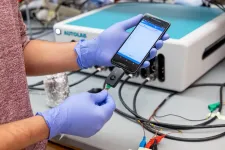Sources of SARS-CoV-2 and other microorganisms in dental aerosols
2021-05-12
(Press-News.org) Alexandria, Va., USA -- COVID-19 was declared a global pandemic in March 2020 and given an incomplete understanding of the transmission of SARS-CoV-2 at that time, the American Dental Association recommended that dental offices refrain from providing non-emergency services. As a result, 198,000 dentists in the United States closed their doors to patients. The study "Sources of SARS-CoV-2 and Other Microorganisms in Dental Aerosols," published in the Journal of Dental Research (JDR), sought to inform infection-control science by identifying the source of bacteria and viruses in aerosol generating dental procedures.
Researchers at The Ohio State University College of Dentistry, Division of Periodontology, Columbus, USA, tracked the origins of microbiota in aerosols generated during treatment of 28 patients undergoing ultrasonic scaling, implant osteotomy or restorative procedures by combining reverse transcriptase qPCR, to identify and quantify SARS-CoV-2, and 16S sequencing, to characterize the entire microbiome, with fine-scale enumeration and source-tracking. Thirty minutes following the procedure, condensate was collected from the operator and assistant's face shield, the patient's chest and an area 6-feet distant from the site of operation.
The results show that it is possible to trace the source of contamination through DNA microbiome analysis and that the major source of microbes in aerosols came from the dental irrigant. Saliva did not significantly contribute as infection control measures such as pre-operative mouthrinses and intra-oral high-volume evacuation were used. The authors conclude that the risk for transmission of SARS-CoV-2 and other respiratory pathogens from aerosolized saliva in dental operatories is moderately low and that current infection control practices are adequately robust to protect personnel and patients alike.
"Understanding the sources of microbial load in aerosols is important, not only for infection control in dental operatories during the COVID pandemic, but also to inform best practices in aerosol reduction, mitigation and abatement in the long term." said JDR Editor-in-Chief Nicholas Jakubovics, Newcastle University, England. "While further studies are needed with larger sample sizes, this study sets the stage for future work on risk of microbial transmission in oral health care settings."
INFORMATION:
View a PDF of this press release.
About the Journal of Dental Research
The IADR/AADR Journal of Dental Research (JDR) is a multidisciplinary journal dedicated to the dissemination of new knowledge in all sciences relevant to dentistry and the oral cavity and associated structures in health and disease. The JDR ranks #3 in Impact Factor of 91 journals, #2 without self-citations, as well as #2 of 91 in Article Influence with a score of 1.627. The JDR's 5-year Impact Factor remained above 5 for the fifth year at 5.844 -- ranking #2 of 91 journals. With over 20,000 citations, the JDR also boasts the most citations in the "Dentistry, Oral Surgery & Medicine" category, over 3,500 citations above the 2nd ranked journal in the field.
International Association for Dental Research
The International Association for Dental Research (IADR) is a nonprofit organization with over 10,000 individual members worldwide, with a mission to drive dental, oral and craniofacial research for health and well-being worldwide. To learn more, visit http://www.iadr.org. The American Association for Dental Research (AADR) is the largest Division of IADR with 3,100 members in the United States. To learn more, visit http://www.iadr.org/aadr.
ELSE PRESS RELEASES FROM THIS DATE:
2021-05-12
Are you empathic, generous and altruistic? In short, do you possess that specific personality trait defined as agreeableness in the language of psychologists? New research from SISSA recently published in the journal NeuroImage sheds light on brain mechanisms underlying this trait.
The study showed that detached and individualistic subjects seem to process information associated with social and non-social contexts in similar ways, as demonstrated by similar activation patterns in the prefrontal cortex, whereas in more agreeable subjects the activation patterns ...
2021-05-12
Peri-implantitis, a condition where tissue and bone around dental implants becomes infected, besets roughly one-quarter of dental implant patients, and currently there's no reliable way to assess how patients will respond to treatment of this condition.
To that end, a team led by the University of Michigan School of Dentistry developed a machine learning algorithm, a form of artificial intelligence, to assess an individual patient's risk of regenerative outcomes after surgical treatments of peri-implantitis.
The algorithm is called FARDEEP, which stands for Fast and Robust Deconvolution of Expression ...
2021-05-12
When Museums closed their doors in March 2020 for the first COVID-19 lockdown in the UK a majority moved their activities online to keep their audiences interested. Researchers from WMG, University of Warwick have worked with OUMNH, to analyse the success of the exhibitions, and say the way Museums operate will change forever.Caption: Compton Verney's homepage for the Cranach exhibition which opened in March 2020 Credit: Compton Verney
The cultural impact of the COVID-19 pandemic has been analysed by researchers from WMG, University of Warwick in collaboration with OUMNH (Oxford University Museum of Natural History) who in the paper, 'Digital Responses ...
2021-05-12
An international research team led by the University of Cologne has succeeded for the first time in connecting several atomically precise nanoribbons made of graphene, a modification of carbon, to form complex structures. The scientists have synthesized and spectroscopically characterized nanoribbon heterojunctions. They then were able to integrate the heterojunctions into an electronic component. In this way, they have created a novel sensor that is highly sensitive to atoms and molecules. The results of their research have been published under the title 'Tunneling current modulation in atomically precise graphene nanoribbon heterojunctions' in Nature Communications. The work was carried out in close cooperation between the Institute for ...
2021-05-12
BOSTON - (May 12, 2021) - Scientists are rapidly gathering evidence that variants of gut microbiomes, the collections of bacteria and other microbes in our digestive systems, may play harmful roles in diabetes and other diseases. Now Joslin Diabetes Center scientists have found dramatic differences between gut microbiomes from ancient North American peoples and modern microbiomes, offering new evidence on how these microbes may evolve with different diets.
The scientists analyzed microbial DNA found in indigenous human paleofeces (desiccated excrement) from unusually dry caves in Utah and northern Mexico with extremely ...
2021-05-12
Surface plasmon polaritons (SPPs) are highly localized surface waves on the interface between metal and dielectric in the optical frequency band. SSPs do not naturally exist in the microwave and terahertz frequencies, so "spoof" surface plasmon polaritons (SSPPs) are necessary for operations in those lower frequency bands.
Like optical SPPs, microwave SSPPs exhibit highly localized electromagnetic fields, subwavelength resolution, and extraordinary field confinement. Therefore, SSPP transmission lines (TLs) have been proposed as novel types of microwaveguides that offer new solutions for miniaturization, ...
2021-05-12
BOSTON - During the development and progression of Alzheimer's disease, a protein called tau accumulates and spreads in the brain. Understanding the mechanisms behind tau spread--and its consequences--may point to new prevention and treatment strategies for Alzheimer's disease and other forms of dementia. New insights now come from research that was led by investigators at Massachusetts General Hospital (MGH) and involves an anesthetic known to affect cognitive function. The findings are published in Communications Biology.
The scientists note that inflammation plays an important role in Alzheimer's disease, and microglia--immune cells that reside in the brain--are thought to be involved in this process by producing an ...
2021-05-12
Since the discovery of Alzheimer's disease over a century ago, two hallmarks of the devastating illness have taken center stage.
The first, known as amyloid plaques, are dense accumulations of misfolded amyloid protein, occurring in the spaces between nerve cells. Most efforts to halt the advance of Alzheimer's disease have targeted amyloid protein plaques. To date, all have met dispiriting failure.
The second classic trait has, until recently, received less scrutiny. It consists of string-like formations within the bodies of neurons, produced by another crucial protein-- tau. These are known as neurofibrillary tangles.
In a new study, researchers with the ASU-Banner Neurodegenerative Disease Center at the Biodesign ...
2021-05-12
PHILADELPHIA--A low-cost, rapid diagnostic test for COVID-19 developed by Penn Medicine provides COVID-19 results within four minutes with 90 percent accuracy. A paper published this week in Matter details the fast and inexpensive diagnostic test, called RAPID 1.0 (Real-time Accurate Portable Impedimetric Detection prototype 1.0). Compared to existing methods for COVID-19 detection, RAPID is inexpensive and highly scalable, allowing the production of millions of units per week.
Despite the urgency of the pandemic, most available methods for COVID-19 testing use RT-PCR--reverse transcription polymerase chain reaction--to detect ...
2021-05-12
Central to any technological progress is the enrichment of human life. The internet and wireless connectivity have done that by allowing not only virtually anyone anywhere to connect real time, but by making possible connections between humans and a range of intelligent devices both indoors and outdoors, putting smart cities on the horizon.
One key aspect of realizing smart cities is "smart vehicles", the latest development in intelligent transportation systems (ITS), which involve the integration of communication, mapping, positioning, network, and sensor technologies to ensure cooperative, efficient, intelligent, safe, and economical transportation.
For decades, research on bringing to the streets smart vehicles that operate ...
LAST 30 PRESS RELEASES:
[Press-News.org] Sources of SARS-CoV-2 and other microorganisms in dental aerosols





